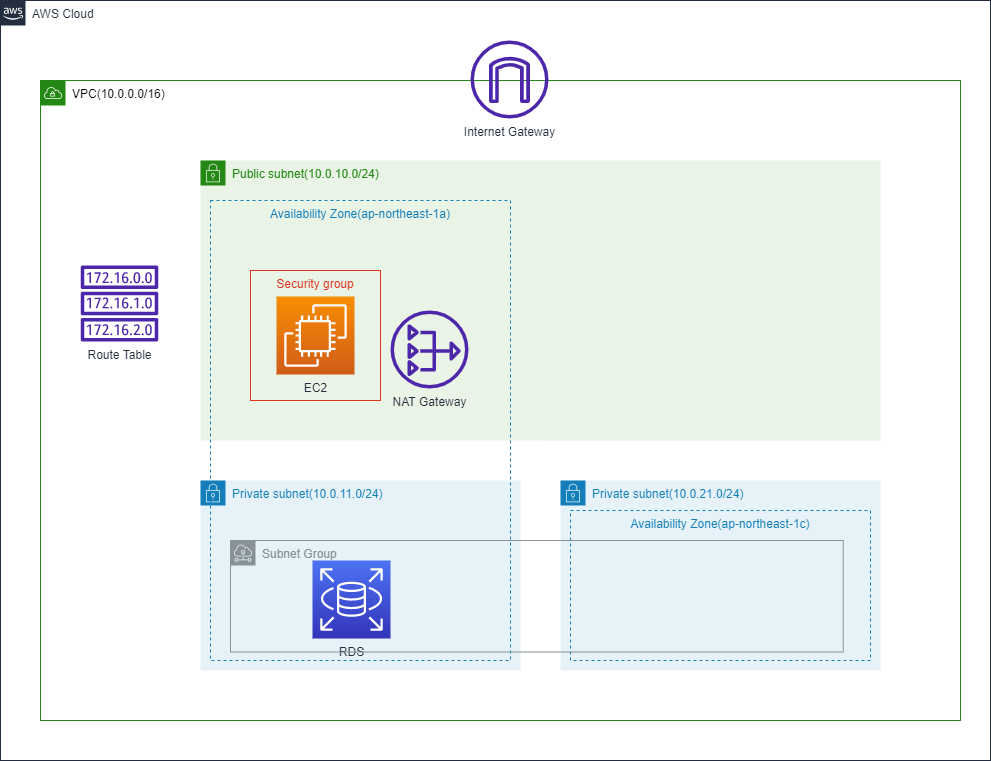記事を書いたきっかけ
- 案件で使った技術をメモとして残しておきたかったから
ぶっちゃけ最近アウトプットしてなかったから
対象者
- Terraform を触れたことがない人
- AWS のマネコンからインフラの立ち上げに飽きた人
動作環境
- Cloud9(設定は全てデフォルトでOK。今回は立ち上げ手順は省略)
- 作成されるリソースが IAM ポリシーに含まれていること
本記事で作るインフラ構成
- パブリックサブネットに踏み台サーバを1台設置
- プライベートサブネットからインターネットに接続させるため、NAT ゲートウェイを設置
- プライベートサブネットにDBサーバを1台設置
ディレクトリ構成
Terraform の立ち上げは一番簡単な方法でやっています。Module は作ってません。
.
|-- main.tf (terraformの初期化・プロバイダ指定)
|-- network.tf (VPC・各種ゲートウェイ・サブネット・ルートテーブルの設定)
|-- security.tf (セキュリティグループの設定)
|-- server.tf(キーペアアップロード・EC2インスタンス・サブネットグループ・RDSの設定)
コード
main.tf
main.tf
# --------------------------------
# main
# --------------------------------
# Terraformの初期化
terraform {
required_version = "~> 1.1.0"
required_providers {
aws = {
source = "hashicorp/aws"
version = "~> 4.0"
}
}
}
# プロバイダ指定
provider "aws" {
region = "ap-northeast-1"
/* Cloud9を使っていて 「AWS managed temporary credentials」 がオンの場合不要。
それ以外の場合は、認証情報が必要になる */
# access_key = "ACCESS_KEY_HERE"
# secret_key = "SECRET_KEY_HERE"
}
network.tf
今回はサブネットグループを作るためだけにプライベートサブネットを2つ作っているため、
subnet-private-2(10.0.21.0/24) とのルートテーブルは作っていません。
network.tf
# --------------------------------
# network
# --------------------------------
# --------------------------------
# VPC
resource "aws_vpc" "main" {
cidr_block = "10.0.0.0/16"
tags = {
Name = "vpc"
}
}
# --------------------------------
# インターネットゲートウェイ
resource "aws_internet_gateway" "main" {
vpc_id = aws_vpc.main.id
tags = {
Name = "igw"
}
}
# --------------------------------
# ElasticIP
resource "aws_eip" "main" {
vpc = "true"
depends_on = [aws_internet_gateway.main]
tags = {
Name = "gw-eip"
}
}
# NATゲートウェイ
resource "aws_nat_gateway" "main" {
allocation_id = aws_eip.main.id
subnet_id = aws_subnet.public.id
depends_on = [aws_internet_gateway.main]
tags = {
Name = "ngw"
}
}
# --------------------------------
# Public
# 1.1 パブリックサブネット
resource "aws_subnet" "public" {
vpc_id = aws_vpc.main.id
cidr_block = "10.0.10.0/24"
availability_zone = "ap-northeast-1a"
map_public_ip_on_launch = true # falseにするとプライベートサブネットになる
tags = {
Name = "subnet-public"
}
}
# 2.1 ルートテーブル
resource "aws_route_table" "public" {
vpc_id = aws_vpc.main.id
tags = {
Name = "rt-public"
}
}
# 2.2 ルートテーブルとパブリックサブネットの関連付け
resource "aws_route_table_association" "public" {
subnet_id = aws_subnet.public.id
route_table_id = aws_route_table.public.id
}
# 2.3 ルート定義 (踏み台サーバ → インターネットゲートウェイ → インターネット)
resource "aws_route" "public_to_internet" {
destination_cidr_block = "0.0.0.0/0"
route_table_id = aws_route_table.public.id
gateway_id = aws_internet_gateway.main.id
}
# --------------------------------
# Private
# 1.1 プライベートサブネット
resource "aws_subnet" "private_1" {
vpc_id = aws_vpc.main.id
cidr_block = "10.0.11.0/24"
availability_zone = "ap-northeast-1a"
map_public_ip_on_launch = false
tags = {
Name = "subnet-private-1"
}
}
resource "aws_subnet" "private_2" {
vpc_id = aws_vpc.main.id
cidr_block = "10.0.21.0/24"
availability_zone = "ap-northeast-1c"
map_public_ip_on_launch = false
tags = {
Name = "subnet-private-2"
}
}
# 2.1 ルートテーブル作成
resource "aws_route_table" "private" {
vpc_id = aws_vpc.main.id
tags = {
Name = "rt-private"
}
}
# 2.2 ルートテーブルとプライベートサブネットの関連付け
resource "aws_route_table_association" "private" {
subnet_id = aws_subnet.private_1.id
route_table_id = aws_route_table.private.id
}
# 2.3 ルート定義 (DBサーバ → NATゲートウェイ → インターネット)
resource "aws_route" "private_to_internet" {
destination_cidr_block = "0.0.0.0/0"
route_table_id = aws_route_table.private.id
nat_gateway_id = aws_nat_gateway.main.id
}
security.tf
security.tf
# --------------------------------
# security
# --------------------------------
# --------------------------------
# 踏み台サーバ
# セキュリティーグループ
resource "aws_security_group" "bastion" {
name = "sg-bastion"
vpc_id = aws_vpc.main.id
ingress { # インバウンド
description = "allow ssh connection"
from_port = 22
to_port = 22
protocol = "tcp"
cidr_blocks = ["0.0.0.0/0"] # あくまで一例です。本番環境でこれをやったら叱られます。
}
egress { # アウトバウンド
from_port = 0
to_port = 0
protocol = -1 # 全てのプロトコル
cidr_blocks = ["0.0.0.0/0"]
}
tags = {
Name = "sg-bastion"
}
}
# --------------------------------
# 踏み台サーバ
# セキュリティグループ
resource "aws_security_group" "db" {
name = "sg-db"
vpc_id = aws_vpc.main.id
ingress {
description = "allow mysql connection"
from_port = 3306
to_port = 3306
protocol = "tcp"
cidr_blocks = ["10.0.10.0/24"]
}
egress {
from_port = 0
to_port = 0
protocol = -1
cidr_blocks = ["0.0.0.0/0"]
}
tags = {
Name = "sg-db"
}
}
server.tf
踏み台サーバにユーザーデータで MySQLをインストールしているが、
RDSに接続するためにインストールしているだけで、ここにはDBを展開しないので注意。
server.tf
# --------------------------------
# server
# --------------------------------
# --------------------------------
# キーペアアップロード
resource "aws_key_pair" "main" {
key_name = "keypair"
public_key = file("/home/ec2-user/.ssh/id_rsa.pub") # SSHキーは後ほど作成
tags = {
Name = "keypair"
}
}
#--------------------------------
# 踏み台サーバ
# EC2インスタンス
resource "aws_instance" "bastion" {
ami = "ami-08a8688fb7eacb171"
instance_type = "t2.micro"
key_name = aws_key_pair.main.id
subnet_id = aws_subnet.public.id
vpc_security_group_ids = [aws_security_group.bastion.id]
tags = {
Name = "bastion-server"
}
user_data = <<-EOF
#!/bin/bash
sudo yum -y install mysql
EOF
}
#--------------------------------
# DBサーバ
# サブネットグループ
resource "aws_db_subnet_group" "db" {
name = "rds-subnet-group"
subnet_ids = [aws_subnet.private_1.id, aws_subnet.private_2.id]
tags = {
Name = "db-subnet-group"
}
}
# RDS
resource "aws_db_instance" "db" {
identifier = "rds-db"
allocated_storage = 10
engine = "mysql"
engine_version = "5.7"
instance_class = "db.t2.micro"
db_name = "db"
username = "hogehoge"
password = "hugahuga"
vpc_security_group_ids = [aws_security_group.db.id]
multi_az = false # trueにするとマルチAZでmaster-slave構成になるので注意
db_subnet_group_name = aws_db_subnet_group.db.id
parameter_group_name = "default.mysql5.7"
skip_final_snapshot = true # 削除する際にスナップショットが自動で作られなくなります
}
起動前の確認
SSHキー作成
$ ssh-keygen –t rsa –b 4096
文法確認
$ terraform validate
dry-run(作成前に構築されるインフラを出力してくれる)
$ terraform plan
起動
$ terraform apply
An execution plan has been generated and is shown below.
Resource actions are indicated with the following symbols:
+ create
Terraform will perform the following actions:
(中略)
Plan: 19 to add, 0 to change, 0 to destroy.
Do you want to perform these actions?
Terraform will perform the actions described above.
Only 'yes' will be accepted to approve.
Enter a value: (yesと入力)
(中略)
Apply complete! Resources: 19 added, 0 changed, 0 destroyed.
踏み台サーバ・RDSに接続
事前踏み台サーバのパブリックIPアドレスと、
DBサーバのRDSエンドポイントを確認すること。
MySQLに接続できれば成功です。
$ ssh -i /home/ec2-user/.ssh/id_rsa ec2-user@(踏み台サーバのパブリックIPアドレス)
(中略)
[ec2-user@ip-xxx-xxx-xx-xxx ~] mysql -h (RDSエンドポイント) -P 3306 -u hogehoge -p
Enter password: (hugahugaと入力)
Welcome to the MariaDB monitor. Commands end with ; or \g.
Your MySQL connection id is 7
Server version: 5.7.36 Source distribution
Copyright (c) 2000, 2018, Oracle, MariaDB Corporation Ab and others.
Type 'help;' or '\h' for help. Type '\c' to clear the current input statement.
MySQL [(none)]>
後片付け
$ terraform destroy
(中略)
Plan: 0 to add, 0 to change, 19 to destroy.
Do you want to perform these actions?
Terraform will perform the actions described above.
Only 'yes' will be accepted to approve.
Enter a value: (yesと入力)
(中略)
Apply complete! Resources: 19 destroyed.
感想
案外簡単にIaCを使うことが出来た。ただ管理するとなると結構難しそうだと感じました。
(また後で記述するかもしれません。初心者のため多少のミスがあるかもしれないので、指摘があると助かります)
